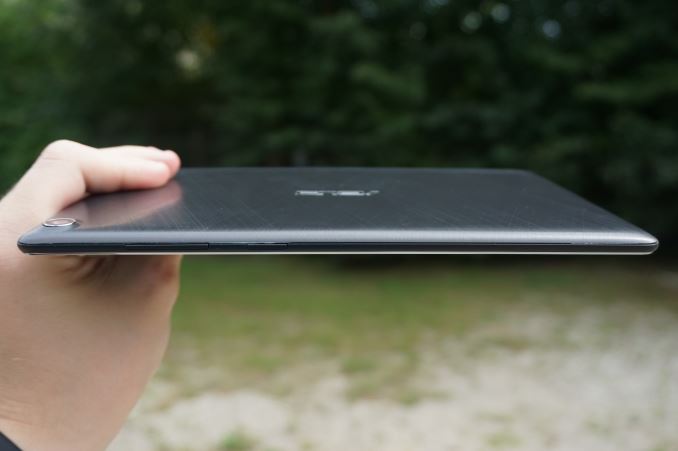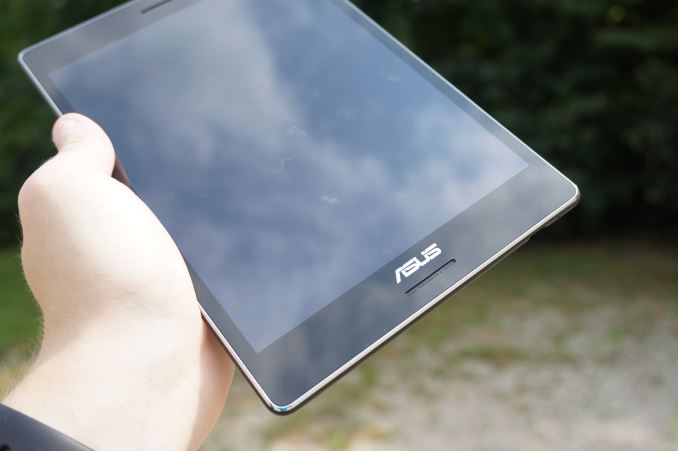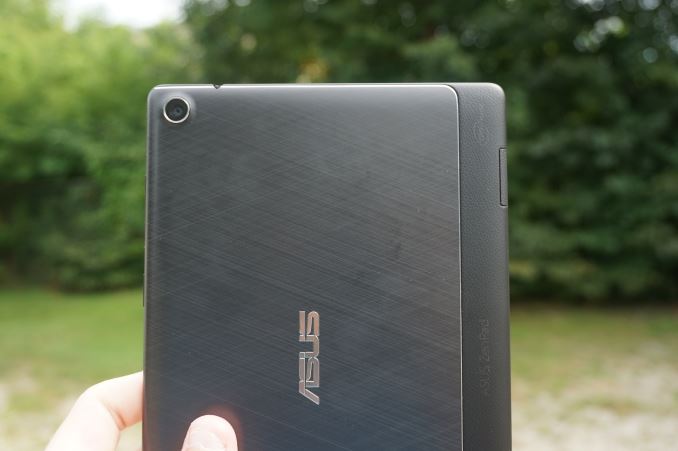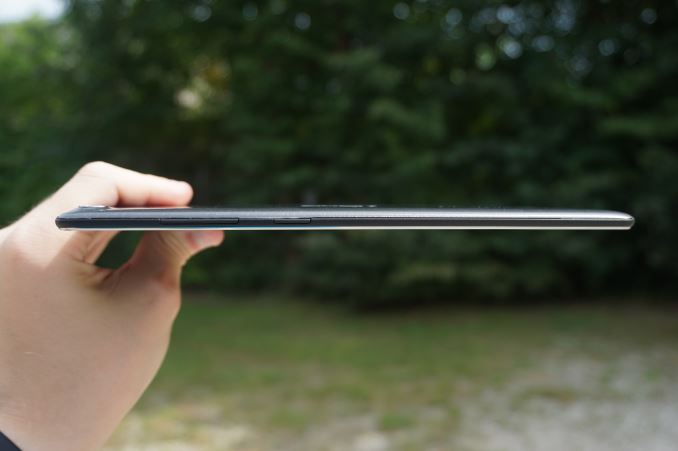The ASUS ZenPad S (Z580CA) Review
by Brandon Chester on August 31, 2015 8:00 AM ESTDesign
In my mind, I think of the ZenPad S Z580CA as a companion to the ZenFone 2. Both devices have an affordable price, and you can really buy both of them and still end up spending less than you would on a flagship smartphone. While they definitely share a UI and many internal hardware components, there isn't much similarity between the external design and construction of the two devices.
The first thing you'll notice when you pick up the ZenPad S isn't how the materials feel, but how incredibly thin and light the entire device feels. It's 6.6mm thick at its thinnest point, and the thickest point is only a small fraction of a millimeter thicker than that. Its mass is only 298g, which makes it the lightest tablet I've looked at to date. While it's not as thin as the iPad Air 2 or the Dell Venue 8 7840, the thickness and mass work together to give a feeling of lightness and portability that I've only ever experienced with one other device, which was the original iPad Mini.
There's not much to say about the front of the ZenPad S. Like all tablets, it's just a big display. ASUS has made space for two front-facing stereo speakers, which is something you won't get on an iPad or on the Galaxy Tab S2. As for the quality of the speakers, my highly subjective evaluation is that they are better than the iPad Air 2, and much better than the Nexus 9. They also don't cause significant chassis vibration despite the tablet's small thickness, which is something the iPad Air 2 suffers from.
Surrounding the edge of the ZenPad's front bezels is a metallic looking silver edge. This is really made of plastic, and like the plastic construction of the ZenFone 2 I'm a bit concerned about its durability. Readers may remember that a single fall from an extremely short height ended up scuffing up the back cover of our ZenFone 2 pretty badly. With the ZenPad S I have made sure to be quite careful, and haven't dropped it or hit it off anything to the best of my knowledge. Even so, there are some small dents in the silver edge. Pressing on it confirms that it's a fairly soft plastic, and I feel like it's going to be a magnet for these types of small dents and marks. In contrast, the Nexus 9 and iPad Air 2 testing units I have could probably be packaged and sold as brand new despite having them in my possession for significantly longer than the ZenPad S. If someone intends to use the ZenPad S as a tablet they can throw into their bag with other objects I would definitely be aware of the potential for damage to the edge.
The back of the ZenPad S is split into two sections. The smaller section has a soft touch feeling, and almost feels a bit like the pleather some phone cases are made of as it has a texture to it. This section is slightly thinner than the rest of the back cover, and it houses the tablet's MicroSD slot. What's interesting is that this part blends smoothly into the sides of the tablet, even though the sides have a distinctly different feeling due to their lack of texture. The soft touch part of the tablet also has the tablet's name and the Intel logo on it. However, it rubs off fairly easily as you can see in the image above, and at the time of writing this paragraph the logos have come off entirely.
The second part of the ZenPad back cover is a large plastic panel. In my review of the ZenFone 2 I said that the back cover of the phone did a good job of mimicking the appearance of aluminum, but felt entirely like plastic. The plastic segment of the ZenPad's back cover could actually convince you that it's made of metal unless you have the urge to tap on it. Like the ZenFone 2, the ZenPad's back cover has a shine to it that looks very much like the reflections made by brushed aluminum, although in the ZenPad's case the back cover has a pattern of overlapping diagonal lines rather than the straight lines of the ZenFone 2. Unfortunately, the hard plastic part of the back cover doesn't give any illusion of the tablet itself being made of metal, as you'll always be touching the soft touch plastic of the sides and the smaller segment of the back.
Right out of the box, my ZenPad S review unit did seem to have some issues with the hard plastic segment of the back cover that I think should have been picked up during QA. As you can see in the images above, there are areas on the edge of the plastic that are warped in such a way that they are no longer smooth like the other sections. It looks like these areas weren't finished properly, and when you look at the tablet from the side you can see that the entire edge around the power button and volume rocker is improperly formed and doesn't have the same color as the rest.
Ultimately I think the ZenPad S does a good job at being what it is, which is a tablet with a plastic chassis. My big concern is that the iPad Mini 2 sits at exactly the same price, and offers a completely aluminum chassis that feels much higher quality and will likely not incur the damage I've seen on the ZenPad's edge and back cover. The iPad is obviously heavier and thicker though, and the only way to achieve the low mass that the ZenPad S has is with plastic.
Personally, I think if I was given the choice I would opt for a slightly thicker and heavier device made of aluminum or a more durable plastic than a thinner and more easily damaged plastic one. The thicker device also has the benefit of storing a larger battery. Other people may value the thinness and the lightness more, particularly with 8" tablets which are more likely to be kept on someone's person than larger tablets. In the end everything is a series of trade-offs, and it's important to think about what aspects of design and build quality matter most to you when considering which tablets to buy.














114 Comments
View All Comments
BugblatterIII - Monday, August 31, 2015 - link
I wasn't even talking about the GPS; way to jump to conclusions and run a mile with them!And I did get the dongle.
3DoubleD knows what he's talking about (oh and don't forget the interminable hangs on web browsing). MrSavage I suggest you read and learn.
My current router and motherboard are from Asus, no complaints. When it comes to tablets (and probably smartphones) I'd steer well clear. This review mentions some serious issues at launch; they shouldn't exist.
MrSavage - Monday, August 31, 2015 - link
If you recall, the Prime just came out, some hadn't even shipped, and Asus showed of the Transformer Infinity at CES to the dismay of many. The fact is this. That was a ground breaking product, in its second iteration. Nobody else was attempting what they did. Design wise a fail? Sure. But to me, I give full credit for a company that has the balls to release innovative and cutting edge products. They didn't repeat the mistake. Hold a grudge? LOL, go ahead. I'll always praise innovation even if it means problems. Apple antennagate? Happens to even the best companies out there.BugblatterIII - Tuesday, September 1, 2015 - link
The bits they failed on weren't the innovative bits. The keyboard worked very well for example. It was the actual tablet bit where they fell down. They shouldn't have shipped it in that state; they used seriously under-specced hardware and that's probably the real reason they were never able to fix it with firmware.A few years on perhaps they've learned, or perhaps the decision-makers have changed. However the fact they're launching with major issues suggests otherwise, and those who do not learn from history are doomed to take Summer School.
You call it holding a grudge; I call it learning from experience. Same reason I won't touch Belkin.
3DoubleD - Tuesday, September 1, 2015 - link
Agreed. The innovative bits were great. The keyboard with extra battery life - fantastic. Screen was beautiful, even if it was only 720p. Two SD card slots and a full sized USB port - great. ASUS' Android wasn't even too bad (pretty close to stock with some small, helpful additions). But screwing up one of the core components of the system was not a failed innovation, it was poor engineering and quality control. It was also a not a common failure that was unique to the Prime, despite all phones and tablets having eMMC devices. It was such a failure, crippling the usability to such an extent that a recall should have taken place. Hilariously, the previous Transformer tablet has aged far better, while having all of the innovative features, so again, I don't think ASUS should get a free pass because it was 'ballsy'.3DoubleD - Tuesday, September 1, 2015 - link
"It was also a not a common failure, *but* was unique to the Prime..."MrSavage - Monday, August 31, 2015 - link
I registered to ask this question. You guys are known for your "technical" analysis. The issue with reviews is with the basis of comparison or lack thereof. Instead of saying this is the best $299 8-inch Android tablet on the market, you can't and really don't. Instead, you suggest spending another 1/3 of the price for something else!? Or yet get an old, outdated iPad mini 2?What are front facing speakers worth to a tablet user? What is a stylus input worth to a tablet user?
It would seem that the reviewer doesn't know the Samsung Tab S2 8.0. Explain what that extra $100 in price gets you, that's better than the $100 cheaper Android tablet. The point is, expand on a spec basis what makes the extra $100 a better buying option. Perhaps your readers only shop for the most expensive product. In that case, each review will be price based. The most expensive on the market = the best. Thus, a review just explains why the premium cost is worthwhile. To write in the review that looking at the $100 more expensive Tab S2 is worth considering? How about why? Why is that worth it?
DanNeely - Monday, August 31, 2015 - link
*sigh* Up until I saw the display and battery sections I was somewhat interested in this tablet.Is there anyone selling an 8" android tablet that isn't either a cheap wretched piece of crap or fundamentally broken in some way (eg Samsung's backwards buttons, Kindle's lack of Google apps, etc)?
MrSavage - Monday, August 31, 2015 - link
Unrealistic consumer? Wants - long battery life, best display on market. Wants - cheapest price possible. Seriously? If battery life is crucial, there are things called external battery packs. $20 perhaps? Not tied into a device and can be used for other devices. Display issues? Check the specs on the new Tab S2 8.0 and then look at the price. I think I go back to the first two words I wrote in this comment. Something to think about.DanNeely - Monday, August 31, 2015 - link
How exactly do you go from my not wanting a cheap piece of crap to my wanting something as cheap as possible? For that matter I just cited Samsung's tablets as an example of a device with a fundamentally broken mis-feature.I want a good tablet without anything stupidly wrong on it. I'd gladly pay $400 for something like the Tab S2 8 if Samsung didn't insist on ruining all of their Android devices by screwing the buttons up.
As it is, the Android tablet market has gotten worse than the PC laptop market. The latter at least has enough options that, even though virtually every product has at least one item where they either cheaped out one component to something awful to save a dollar on the BOM or made an generally idiotic design option, I can at least find something that doesn't have a flaw that's a show stopper for me. (XPS 13 laptop, the black tape lens cap on the neckbeard/nose hair camera is less noticeable than the tape over a more conventionally placed camera.) I've been on/off looking for an android tablet all summer; but every time I see something to catch my eye midway through the review there's something that triggers an immediate "OH HELL NO!!!" response.
MrSavage - Monday, August 31, 2015 - link
You are simply being unrealistic, that's my point. Android isn't Apple. Go ahead and go spec by spec through the Z580CA and Tab S2 8.0 comparison and then add the extra $100 you would be spending on that new Samsung.If you think for a moment that the Z580CA is a cheap piece of crap, then no doubt why you are without an Android tablet. You are taking this review as the final word.
Battery life can be solved pretty darn easily, unless their is some issue with portable charger and Type-C.
I am curious though, what's the "hell no" aspect of the Z580CA? I hope it's not the wifi which has been reviewed on a firmware that needs updating/tweaking.
Display wise? I think the reviewer has a built in bias against display enhancements. Lots of charts and graphs talking about display. However, do you really think any of those graphs and charts mean anything to the real world, end user? If you are an elite user, then go ahead and look outside of Android and pay double or triple the price for an Apple display.
I hear what you want. You want an Apple quality device with Android OS. I think the manufacturers have tried and failed at that game and it's why price is their primary goal. Perhaps you can hope for a ZenPad Pro or something similar.
Personally? I would rather have a thicker, heavier and even slightly higher priced Z580CA if it meant bigger battery. However, I can easily get around battery life issues. No ideal, but possible.
Front facing speakers are of no value to you? Stylus input is of no value to you?
The bad thing about charts is that a device which is priced 20% to 40% cheaper will be compared against the most premium expensive models on the market. Is it logical to have them all bunched together? Do car review put Ferrari's against Honda in their speed or performance comparison tests? Some comparisons are illogical.